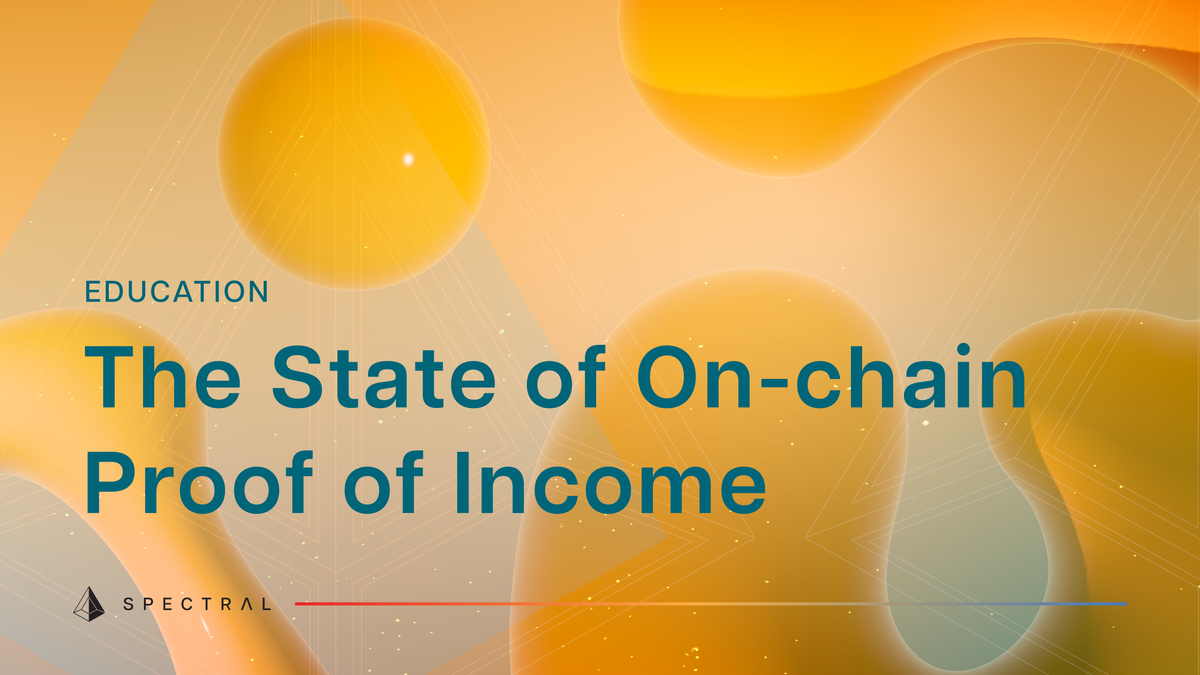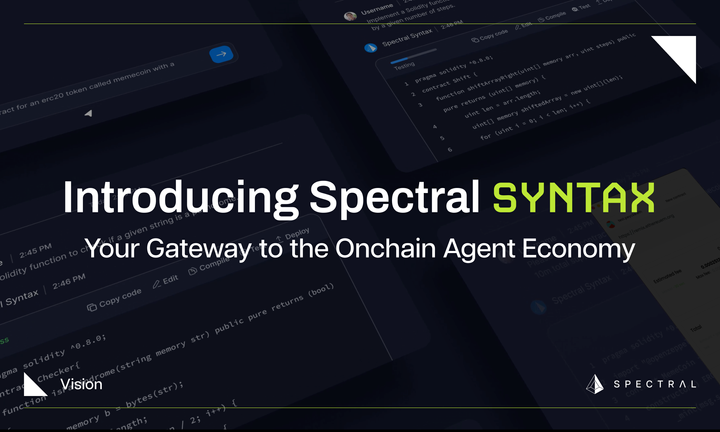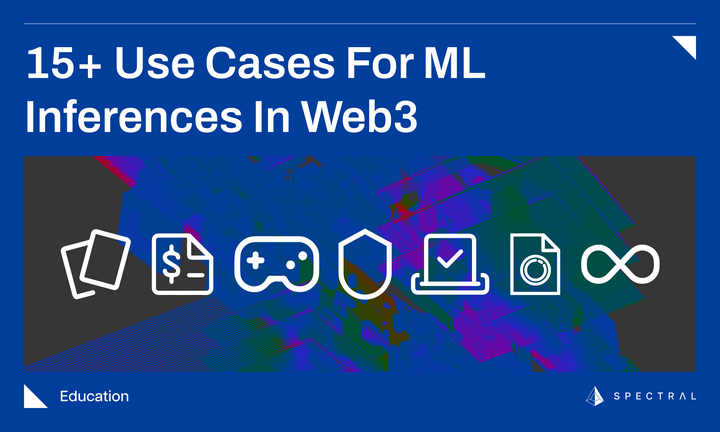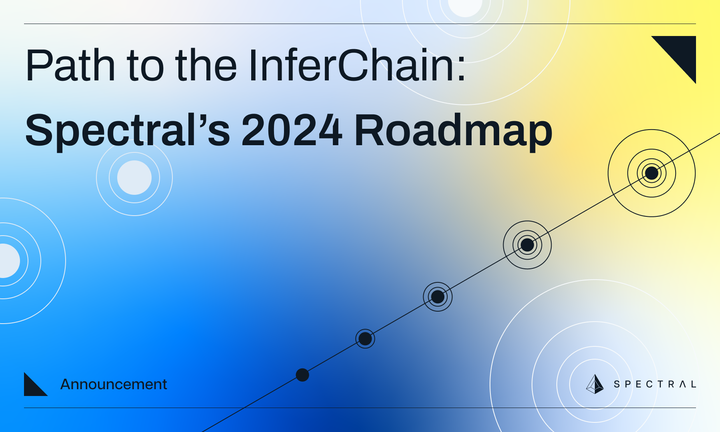The State of On-chain Proof of Income
A primer on proof of income, an emerging aspect of web3. Find out what it is, read about key players, concepts, and how Spectral is beginning to approach the data science behind it.

There is no better way to predict creditworthiness than income, i.e. future receivables, invoices, equity, and payroll. A number of web3 companies, including Spectral, Huma Finance, Request Finance, Bulla Network, Sablier, and Superfluid have begun tracking on-chain income in the hope of creating dependable proof of income. Here’s where we’re at today.
On-chain lenders can usually only offer their users fully (or over) collateralized loans. This means borrowers must stake the entire amount they wish to borrow and then some to take out a loan. Otherwise borrowing on a trustless exchange is simply too risky. Yet, as more business moves on-chain, the web3 community will eventually achieve a critical mass of on-chain information capable of allowing lenders to identify and trust their borrowers.
Decentralized finance (DeFi) replaces traditional banking functions, brings them on-chain, and automates them. First, there were transfers, then came payments, then the equivalent of money market accounts and exchanges and protocols offering lending and borrowing services. One of the next pieces of the DeFi puzzle to be solved is proof of income.
Cryptocurrency projects are increasingly paying their employees using invoice systems like Request Finance or providing streams of income like Sablier or Superfluid and by incorporating that information into our models, Spectral can help other protocols better understand a wallet’s financial reputation, and forecast potential sources of risk. Creditworthiness is one avenue benefiting from transparent income streams. From the beginning of credit scoring, credit bureaus recognized that the most solid and dependable borrowers made steady payments and received steady incomes. By incorporating on-chain income streams into these factors, dApps could create products like internationally portable mortgages or credit streams.
How Traditional Finance Uses Proof of Income
A lack of diligence in mortgage lending during America’s housing bubble may have partly been to blame for the 2008 credit crunch. Traditional finance approaches income verification in a number of ways, much of it self-reported, although larger loans typically require third-party verification. This can take the form of paystubs, income tax records, or bank records demonstrating a recurring series of payments, usually spanning a certain amount of time.
While income is a top-ranking factor for determining creditworthiness in traditional finance, the ability to repay and one’s history of making on-time payments are also significant factors in determining creditworthiness. The web3 ecosystem is rapidly building out the informational infrastructure for recording and maintaining this information.
Key Players in the On-Chain Proof of Income Space
- @humafinance - Huma Finance enables both on-chain and off-chain income to be used as collateral in borrowing.
- @Spectralfi - Spectral generates on-chain creditworthiness MACRO Scores and wallet signal intelligence and analysis.
- @transposedata - Transpose offers real-time blockchain data for applications and enterprises at scale.
- @Sablier Sablier creates streaming payments, allowing permissionless equity and vesting transfers.
- @Superfluid_HQ Superfluid is a money streaming protocol that brings salaries, subscriptions, vesting, and other rewards to DAOs and crypto-native businesses worldwide.
- @RequestFinance, which has processed over $300m in crypto payroll, expenses and invoices in multiple tokens and currencies.
- @RequestNetwork is the protocol upon which Request Finance is built. It provides open-source infrastructure for payment requests and notably supports transferable receivable income NFTs.
- @SuberraProtocol allows recurring payments and other web3 payments like subscriptions, invoices, and purchases.
- @0xsplits is a protocol that uses a smart contract to divide all ETH & ERC20 tokens it receives among the recipients according to the ownership shares they define.
- @DiagonalFinance is a protocol allowing subscriptions and other payments.
- @getmasafi offers soulbound token-based identity and credit score
Superfluid
There aren’t many varieties of payment available to you as an employer: you can offer a lump sum to your employees and contractors or make payments on a weekly, biweekly, or bimonthly schedule (or, rarely, offer an annual sum). These terms work reasonably well for salaried workers but seem wildly out of date in a world of DAOs and short-term contracts scattered all over the web3 world. Enter Superfluid.
Superfluid is a crypto asset streaming protocol that facilitates hyper-efficient value transfer in web3 by enabling second-by-second salaries, subscriptions, and vesting — all on-chain.
Superfluid streams transfer value in a constant flow over time between wallets, in a non-custodial (funds are never locked in a smart contract), and permissionless way. In practice, when a DAO contributor is paid in a Superfluid stream, that contributor is paid every second that they work – allowing them to take full advantage of web3 composability and automatically transfer vested tokens to DeFi products for liquidity provision, staking, or yield farming. The protocol uses a token-centric EVM smart contract framework centered around the Super Token, an extension of the ERC20 standard that has powerful value-movement value-movement abilities beyond the basic "transfer".
It’s important to note that Superfluid is first and foremost a protocol built with developers in mind. Streams are programmable, composable, and modular, allowing for the creation of completely new and unique financial experiences and applications. To date, over 600 projects have been built with Superfluid — including real-time investing apps, crypto-native subscription platforms, and more.
Request Finance
Request Finance, is one of the longest-serving income products in web3. They’ve helped to simplify and automate over $300m of dollars worth of payroll, expenses, and invoices for over 2,000 Web3 teams like The Sandbox, Decentraland, and MakerDAO.
The app is also compatible with both traditional and crypto-native tax and accounting software, as well as integrations with Huma Finance and Superfluid.
More recently, the app has been adding features, such as team roles and permissions, direct wallet to bank on/off ramps, API access, cross-chain functionality, and new products like an expenses mobile app.
Sablier
Sablier is a token streaming protocol available on Ethereum, Optimism, Arbitrum, Polygon, Avalanche, and BSC. It is the first of its kind to have ever been built in DeFi, tracing its origins back to 2019. Sablier is being used by hundreds of organizations around the world like Nouns DAO, Shapeshift, Aragon, and Astaria, to handle vesting, payroll, airdrops, and more.
Similar to how you can stream a movie on Netflix or a song on Spotify, Sablier lets you stream money every second. Sablier’s streaming protocol reached a cumulative TVL of $1.5B back in 2021, making it the largest token streaming protocol in the ecosystem.
The protocol was built to last, and has never been hacked in its four years of existence.
The Opportunities of Proof of Income
Huma Finance is the pioneer in income-backed on-chain lending. The reason they prefer income as collateral to ETH as collateral is that it makes DeFi a lot more accessible. Essentially they can open their market up to the 99 percent who don’t have enough blue-chip crypto assets to collateralize their loans, yet are perfectly capable of repaying a loan.
Traditionally, the first thing institutions ask for is proof of income, but that hasn’t been the case in web3 thus far. To determine income, Huma can tokenize many types of income, on-chain or off-chain, including web3 payment streams, and web3 invoices. Working with Request Network and Request Finance, they’ve created a transferable financial primitive (ERC-721) similar to Spectral’s MACRO Score NFCs.
Wondering what Huma Finance does and what exactly income backed lending is? Catch it all in our short and sweet explainer 👇🟣 pic.twitter.com/8ORmahUDzP
— Huma Finance @ Consensus (@humafinance) March 20, 2023
According to a Request Finance press release, “If Alice issues an invoice to Bob with a credit period of 90 days, Alice could mint a RequestNFT and sell it to Huma for immediate financing. Then Huma's lending pool becomes the recipient of Bob’s payments.”
Aside from judging creditworthiness and creating internationally portable lending products that use on-chain income, the transparency, decentralization, and composability of an on-chain proof of income can create new primitives in the form of streams of income (like annuities), they can provide immediate insight for payroll departments and offer opportunities for automating payroll management positions, and offer insights into productivity versus expenditure.
Obstacles Facing the Development of Proof of Income
The biggest obstacle facing the web3 ecosystem’s ability to incorporate proof of income information into their risk models is the quantity of data available. Accessing blockchain data is slow and often expensive. To create the MACRO Score, Spectral relied on over four years of DeFi data accounting for millions of transactions and hundreds of thousands of wallets. The number of users relying on on-chain payments is much lower than that, although some categories of income, such as staking returns could provide significant amounts of data.
Transpose is a high- and low-level blockchain data provider that is tackling the inconsistency of protocol-level data by creating design-optimal schema that can be used for all protocols in a particular vertical, ensuring data is compatible, consistent, and predictable to work with. This helps tackle an enduring problem in web3, that data within protocols serving the same purpose, such as DEXes, NFT Exchanges, mixers etc. are often inconsistent.
How Spectral is beginning to define Proof of Income
WALLET SIGNALS (DATA PACKS) FOR INCOME ACTIVITY
- Wallet_Total_Current_Balance_ETH
- Wallet_Total_Incoming_TXNs
- wallet_current_balance_stablecoin_percentage
- wallet_current_balance_topcoin_percentage
- Wallet_total_area_in_eth
HOW DO WE INFER ON-CHAIN ACTIVITY RELATED TO STREAMS OF INCOME USING THESE DATA PACKS?
Next steps
- Fetch addresses using protocols now, find what they’re doing
- Limit to Superfluid, Request Finance
- Measure staking income
- Relevant Subgraphs
Are you interested in discussing the evolving Proof of Income ecosystem? Check out a discussion in progress on our Discord.




